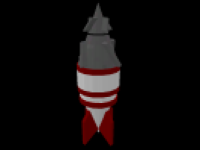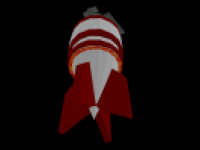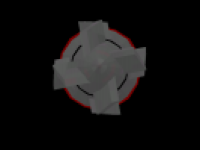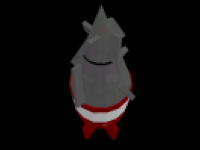Table of Contents
Electron Drill Missile
An Electron Drill Missile designed by Motoyoshi Fleet Yards in YE 30.
| Electron Drill Missile | |
|---|---|
| Designer | Motoyoshi Fleet Yards, Kage Yaichiro |
| Nomenclature | Discontinued Product, No Nomenclature Found |
| Manufacturer | Motoyoshi Fleet Yards |
| Fielded by | Star Army of Yamatai and United Outer Colonies Peacekeeping Forces |
| Production | Discontinued Product |
| Damage Rating | Damage Rating (Version 3) Tier 12 |
| Price | Negotiated |
Legacy Product Information
Motoyoshi Fleet Yards was acquired by the Yugumo Corporation in YE 41. These systems were deployed in vessels produced prior to that year and have been discontinued. Product Source is currently salvage and stockpiled stock and is no longer being produced. Please contact the Yugumo Corporation for more information.
Ships that used this system:
History and Development
After the invention of the Electron Countermeasure, SIP director and Fifth Expeditionary Fleet Officer Kage Yaichiro continued working on the concept, and elected to make the device slightly more offensive than defensive. This, however, would likely be produced by Motoyoshi Fleet Yards, as it contains no restricted technology.
Deciding that the best way to defend against positron weapons would be to overload enemy weapons, the Electron Drill Missile is designed to drill far enough to reach the inner hull and the power conduits, and dump the electrons into the ship's power system…or directly into any positron stores or positron generation devices, should they be in close enough proximity to do so.
The missile is also capable of disrupting both subterranean and conventional power lines and systems, making it a possible choice for attacking Mishhu cities and disrupting their defenses without completely destroying the salvageable technology or the victims they contain. While this may not be the main aim of the war effort, the situation may present itself where brute force against an enemy stronghold is not the most viable option, should hostages be involved.
Statistics
The general statistics for this weapon are as follows:
- Primary Purpose: Offensive
- Secondary Purpose: Tactical Energy Denial
- Damage Rating (Version 3) Tier 12
- Area of Effect: Initial point of impact and affected systems, much larger in case of antimatter reaction
- Range: 2 LY maximum, 0-40 AU practical
- Speed: 0c - .375c
- Dimensions: 2.5m x 75cm x 75cm
Operation
The missile is launched as a conventional high STL missile, though the nose is actually a drill capable of revolving at an incredibly high speed. The unit uses a scaled-down software VRM for its simple guidance system (compared to an IES) which works with the IES from which it was launched within a range of two light-years. Beyond that, or upon order, the missile will use its electron payload to overpower its systems, intentionally rendering itself harmless.
The goal is to hit the enemy ship and drill into its inner hull, often to deliver the electrons as a massive power surge to the ship's systems. It is also used to target systems such as engines and weapons, which can be more vulnerable. However, the best use is to use it to attack Positron weapons systems and act as the catalyst for an antimatter explosion.
Systems
The following systems were part of this weapon:
Power Source
To power its systems without depleting its electron payload, a super-simple and compact nuclear fusion reactor is utilized, to drive the onboard computer, propulsion, and the drill.
STL Engine
This unit uses a high-efficiency steerable STL Engine capable of speed modulation. The engine will often modulate speed, conserving fuel when it is not being fired upon, but it still only has a practical range of 20-40 AU.
Computer
A solid-state digital computer is used, though it can be superseded and controlled by authorized IES systems utilizing proper access codes. The computer may be simple, but the access codes and communication frequencies change in a matter of picoseconds, and are randomized and assigned by the ship which opened fire.
The computer is capable of repelling hacking attacks, guiding the unit, and evading enemy fire if given enough time to react. It is also able to manipulate the tendrils of the unit.
Communications
The unit uses subspace and radio communications on randomized frequencies to receive commands from the ship which fired it.
Payload
The payload is 250 kg of electrons which can be used to interfere with ship systems or to detonate stockpiles/generators of positrons within nearby positron weaponry and catalyze antimatter reactions within the systems of the enemy ship.
Drill
The drill, which is 75cm by 75cm by 1m, is made of Reinforced Durandium and can penetrate hulls with fair ease. While it cannot drill completely through Yamataium or Zesuaium, it only needs to go as far as the power conduits in the inner hull to achieve its objective.
If the Tendrils are damaged, the drill can act as a path for the electrons to escape should the computer deem it necessary or should the computer be disabled by the impact.
Tendrils
The tendrils emerge from inside the frontal fuselage, from behind the drill, and wrap around power conduits or systems which are to be attacked. While not critical to the missile's operation, these units allow for the more efficient attack…assuming the computer has not been knocked out. In the case of computer failure, the payload is delivered through the drill.
Fuselage
This Durandium fuselage is 1.5m long and contains systems other than the drill. At the drill housing, it measures 70cm wide and tapers slightly to 60cm at the engine. It is designed for optimal durability to cost ratio.



